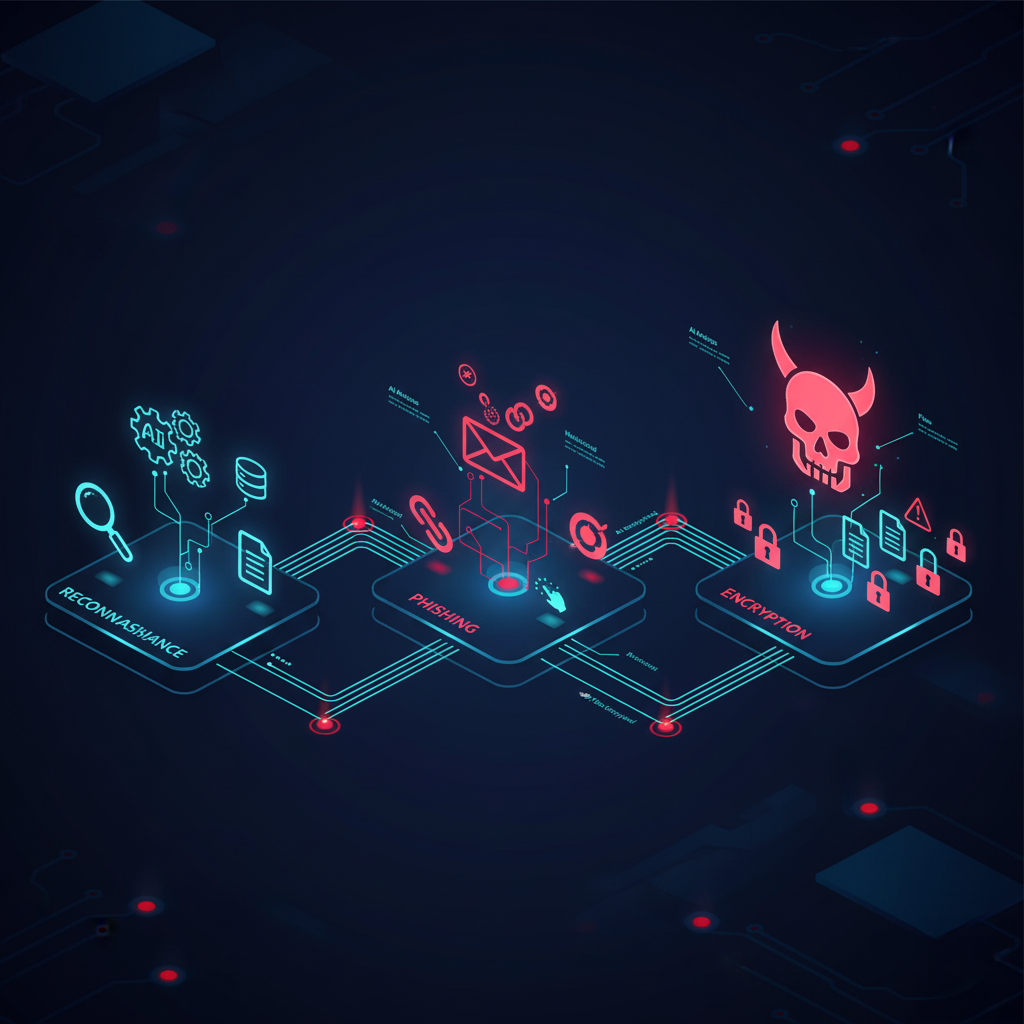The age of predictable, script-based ransomware attacks is over. A staggering 80% of modern ransomware attacks are now powered by artificial intelligence, a finding from a landmark study by MIT Sloan and Safe Security[1]. For Chief Information Security Officers (CISOs) and IT leaders in the UAE, this isn’t just another evolving threat—it’s a paradigm shift. AI-powered ransomware moves at machine speed, adapts to defenses in real-time, and creates hyper-realistic social engineering lures that bypass even seasoned employees. The challenge is compounded by the UAE’s complex and maturing regulatory landscape, leaving many leaders struggling to build a defense that is both technically robust and fully compliant.
This is not another article listing generic security tips. This is the CISO’s playbook for AI-ransomware resilience in the UAE. We will translate the nation’s ambitious cybersecurity and AI strategies into an actionable, multi-layered defense framework for your organization. You will learn how to demystify the threat, understand the specific risks within the UAE, navigate your compliance mandates, and implement a practical defense across your technology, governance, and people. This guide will show you how to turn your regulatory obligations into a decisive competitive advantage.
The New Threat Paradigm: What Exactly Is an AI-Powered Ransomware Attack?
At its core, an AI-powered ransomware attack uses machine learning and other artificial intelligence techniques to automate and amplify every stage of a cyberattack. Unlike traditional ransomware that often relies on static code and broad, unsophisticated phishing campaigns, AI-driven attacks are dynamic, adaptive, and relentlessly efficient. They think, learn, and react to a target’s environment, making them one of the most sophisticated cyber attacks today.
To understand the gravity of this AI ransomware threat, consider the evolution of the attack chain:
| Attack Stage | Traditional Ransomware | AI-Powered Ransomware (The Upgrade) |
|---|---|---|
| Reconnaissance | Manual or slow-scripted scanning of public networks for open ports and known vulnerabilities. | Autonomous Target Selection: AI algorithms continuously scan the internet, identifying high-value organizations, discovering exploitable vulnerabilities, and even analyzing financial reports to pinpoint targets most likely to pay a large ransom. |
| Initial Access | Broad, generic phishing emails with suspicious links or attachments. | Generative AI Phishing: AI crafts hyper-personalized and context-aware phishing emails, SMS messages, or even deepfake audio/video calls that convincingly mimic trusted colleagues or executives. |
| Execution & Evasion | Uses known malware signatures that can be caught by traditional antivirus software. | Dynamic Evasion: The AI-driven malware constantly alters its own code (polymorphism) to avoid signature-based detection, effectively becoming a new threat every few minutes. |
| Lateral Movement | Relies on stolen credentials or known exploits to slowly move across a network. | Autonomous Lateral Movement: Once inside, the AI autonomously maps the network, identifies critical data assets, and spreads to other systems at machine speed, often faster than human security teams can react. |
| Data Exfiltration & Encryption | Encrypts files and demands a ransom for the decryption key. | Double Extortion & AI Analysis: The AI first identifies and exfiltrates the most sensitive data (intellectual property, customer data, financial records) before encrypting the system. The ransom demand is then based on the AI’s analysis of the stolen data’s value. |

How AI Makes Ransomware Faster, Smarter, and Harder to Detect
The primary advantage AI gives to attackers is speed. According to research from cybersecurity leader CrowdStrike, 76% of global organizations struggle to match the speed and sophistication of AI-powered attacks[2]. This velocity is achieved through several key enhancements:
- AI-Driven Reconnaissance: Before an attack even begins, machine learning algorithms can sift through terabytes of public data—from social media profiles and company websites to technical forums—to build a detailed profile of an organization and its key employees. This allows attackers to identify high-value targets and craft perfectly tailored social engineering campaigns automatically.
- Hyper-Personalized Social Engineering: Generative AI can create phishing emails that are indistinguishable from legitimate communications. It can reference recent projects, mimic the writing style of a CEO, or even create deepfake voice notes asking for an urgent fund transfer.
- Adaptive Evasion: AI-powered malware is not static. It can analyze the security tools present on a network and modify its behavior to avoid them. If it encounters a sandbox, it can remain dormant. If it detects an Endpoint Detection and Response (EDR) tool, it can change its communication methods to appear as legitimate network traffic.
The UAE Threat Matrix: Local Risks and High-Value Targets
While AI ransomware is a global threat, its impact in the UAE is shaped by the nation’s unique economic and digital landscape. The UAE’s position as a global hub for finance, trade, and logistics makes it a prime target for sophisticated cyber attacks. The UAE Cybersecurity Council has issued stark warnings, noting that a staggering 98% of cyberattacks in the country exploit human weaknesses[3].
The scale of the problem is immense. Industry reports indicate that up to 66% of UAE-based businesses have reported data breaches, and the Cybersecurity Council has warned that as many as 1.4 billion accounts are hacked monthly on a global scale, highlighting the pervasive risk[3]. The financial consequences are severe, as demonstrated by a landmark Dhs185 million fraud case where cybercriminals used sophisticated techniques to compromise a company, a stark reminder of the real-world impact of these breaches handled by Dubai Courts[4].
Beyond Ransomware: Business Email Compromise (BEC) and Insider Threats
While AI ransomware grabs headlines, it is often enabled by other sophisticated attacks that are rampant in the UAE. Business Email Compromise (BEC) is a particularly potent threat in Dubai’s trade-heavy economy, where attackers impersonate executives or suppliers to authorize fraudulent wire transfers.
Furthermore, the risk from within cannot be ignored. A report from Proofpoint found that 36% of companies in the Middle East report employees unknowingly or knowingly aiding attacks[5]. This highlights the critical danger of insider threats. The Dubai Government has been proactive in addressing this, issuing official guidance on the security risks of using personal email on work devices, which can serve as an unsecured entry point for attackers[6].
Understanding the nuances of these social engineering attacks is the first step to building a defense:
| Attack Type | Target | Method | Example |
|---|---|---|---|
| Phishing | Broad, non-specific group | A generic email sent to thousands of users, often impersonating a large brand (e.g., a bank or a shipping company). | “Your account has been suspended. Click here to verify your details.” |
| Spear Phishing | A specific individual or small group | A customized email using personal information (name, job title, recent projects) to build trust and credibility. | “Hi [Employee Name], here is the Q3 performance report you asked for. The password is…” |
| Whaling | High-level executives (C-Suite) | A highly targeted spear phishing attack aimed at senior leadership with the goal of tricking them into making high-value wire transfers or revealing strategic information. | An email seemingly from the CEO to the CFO asking for an urgent, confidential wire transfer to a new vendor account. |

The CISO’s Mandate: Navigating the UAE’s Cybersecurity and AI Regulations
For CISOs in the UAE, building a defense against AI ransomware is not just a technical challenge—it is a compliance mandate. The UAE government has established a sophisticated, multi-layered regulatory ecosystem that sets clear expectations for how organizations must manage cybersecurity and artificial intelligence. Competitors often mention these frameworks superficially, but understanding how they interlink is critical to building a truly defensible posture.
- The UAE National Cybersecurity Strategy: This is the nation’s overarching policy aimed at creating a safe and resilient cyber infrastructure[7]. For businesses, this translates into an expectation to implement robust security controls, protect critical assets, and contribute to the national cybersecurity ecosystem.
- The Dubai Cyber Security Strategy: This initiative focuses specifically on protecting the emirate from cyber threats, with pillars covering innovation, cyber resilience, and international collaboration. It sets a high bar for entities operating within Dubai, particularly in critical sectors.
- UAE National Strategy for Artificial Intelligence 2031: This forward-looking strategy encourages AI adoption but also implies a responsibility for secure and ethical implementation[8]. For any company using AI—whether in its products or its security tools—this strategy mandates a focus on AI governance, data privacy, and security by design.
Beyond these national strategies, organizations operating in financial free zones must also adhere to advanced data protection laws, such as the frameworks established in the Dubai International Financial Center (DIFC) and Abu Dhabi Global Market (ADGM), which are aligned with global standards like GDPR.
Your Actionable Playbook: A Multi-Layered Defense Framework
Understanding the threat and the regulations is the first step. Now, it’s time to build your defense. This playbook provides a practical, three-pillar framework to help you achieve both compliance and resilience against AI-powered threats.
Expert Insight
“In the UAE, defending against AI-driven attacks requires an integrated strategy. You cannot simply buy a new technology and consider the problem solved. True resilience comes from aligning your AI-powered defense tools with a strong governance framework that meets national standards, and then empowering your people to become your first line of defense. The three pillars—Technology, Governance, and People—must work in unison.”
Download Your Essential Guide
Get a head start on compliance and resilience. Download our exclusive ‘UAE Cybersecurity & AI Governance Compliance Checklist’ to audit your practices against key local regulations and strategic frameworks.
Pillar 1: Technology – Fighting AI with AI
Conventional, signature-based security tools are no match for adaptive AI threats. The only effective technological defense is to fight AI with AI. This involves adopting a new generation of security solutions that can predict, detect, and respond to threats at machine speed.
This is a priority for security leaders in the region. The 2025 Proofpoint Voice of the CISO report reveals that 58% of UAE CISOs are actively exploring AI-powered security solutions[5]. Key technologies to prioritize include:
- Adversarial Artificial Intelligence: This is a defensive strategy where you use your own AI to probe your systems for weaknesses, just as an attacker would. It helps you find and fix vulnerabilities before they can be exploited.
- AI-Driven Threat Detection: These platforms analyze vast amounts of data from your network, endpoints, and cloud environments to identify anomalous patterns of behavior that signal an attack in progress, even if the malware itself has never been seen before.
- Endpoint Detection and Response (EDR): EDR solutions go beyond traditional antivirus by continuously monitoring endpoints (laptops, servers) for suspicious activity and providing the tools to investigate and remediate threats automatically.
- Secure Access Service Edge (SASE): SASE combines network security and wide-area networking into a single, cloud-delivered service. It ensures that security policies are enforced consistently, whether your employees are in the office or working remotely.
Pillar 2: Governance – Implementing a UAE-Compliant AI Framework
Technology alone is not enough. Robust governance is required to manage the risks associated with AI and ensure compliance with the UAE’s national strategies. A clear AI governance framework is no longer optional. In fact, 59% of UAE CISOs have already implemented AI usage guidelines within their organizations[5].
Establishing an effective framework involves several key components:
- Asset Inventory and Risk Assessment: Identify all AI systems used within the organization and assess the potential security and compliance risks associated with each.
- Data Management and Privacy: Establish clear policies for how data is collected, used, and protected by AI systems, ensuring alignment with UAE data protection laws.
- Secure AI Development Lifecycle: If developing AI tools in-house, integrate security checks and ethical reviews at every stage of the development process.
- Third-Party AI Risk Management: Vet any third-party AI vendors to ensure their security practices meet your standards and comply with local regulations.
- Incident Response Plan: Update your incident response plan to specifically address AI-related security incidents, including data poisoning or model evasion attacks.
For a globally recognized, non-commercial starting point, many organizations look to the AI Risk Management Framework | NIST as a foundational guide to build upon[9].
Pillar 3: People – Building Your Human Firewall
Since 98% of attacks in the UAE exploit human weakness, the human element is arguably the most critical pillar of your defense[3]. However, a concerning finding from Proofpoint’s research shows that nearly one in four UAE organisations lack a specialized team for insider threats[5]. Building a strong security culture is paramount.
Actionable steps to fortify your human firewall include:
- Establish an Insider Threat Program: This isn’t about spying on employees. It’s about creating a program that identifies risky behaviors (e.g., unusual data access, attempts to bypass security controls) and provides proactive training and support.
- Continuous Security Awareness Training: Move beyond a once-a-year training session. Implement a continuous program with regular phishing simulations that mimic the sophisticated, AI-generated lures your employees will face.
- Focus on BEC Prevention: Train your finance and executive teams specifically on how to spot and verify requests for wire transfers or changes to payment details. Implement a multi-person approval process for all financial transactions.
- Empower Employees to Report: As recommended by authoritative bodies like the U.S. Cybersecurity and Infrastructure Security Agency (CISA), create a simple, blame-free process for employees to report suspicious emails or activities. The faster they report, the faster your team can respond[10].

Building Resilience: Foundational Security Hygiene for Every UAE Business
Alongside the advanced, three-pillar framework, every organization must master the fundamentals of cyber hygiene. This is the definitive guide to the non-negotiables, based on best practices from global authorities like CISA, the NSA, and the UK’s NCSC. These are not just tips; they are the bedrock of any resilient security posture.
The reason these steps are so critical is that they close the most common entry points that ransomware exploits. For example, updating software patches known vulnerabilities, preventing attackers from gaining an initial foothold.
Essential First Steps: Passwords, Updates, and Backups
- Enforce Strong Authentication: A strong passcode is your first line of defense. It should be long, complex, and unique for every critical account. As recommended by financial security experts at Bank of America, never reuse passwords, especially for financial or email accounts[11].
- Maintain Rigorous Software Updates: As CISA recommends, enabling automatic updates for operating systems, browsers, and applications is one of the most effective steps you can take to protect against ransomware[10]. This ensures that known security holes are patched before attackers can exploit them.
- Implement a Bulletproof Backup Strategy: In the event of a successful ransomware attack, your backups are your last line of defense. Follow the 3-2-1 rule recommended in CISA’s #StopRansomware guide: keep 3 copies of your data, on 2 different types of media, with 1 copy stored off-site and offline[10]. Regularly test your backups to ensure you can restore data quickly and reliably.
From Compliance Burden to Competitive Advantage
AI-powered ransomware represents a fundamental shift in the cyber threat landscape. It is faster, smarter, and more adaptive than anything security leaders have faced before. For CISOs in the UAE, this is a strategic business risk, not just a technical IT problem. The nation’s forward-thinking cybersecurity and AI strategies provide a clear roadmap, but they also create a mandate for action.
A reactive, technology-only approach is doomed to fail. Resilience can only be achieved through a multi-layered playbook that integrates advanced technology, robust governance, and a security-aware workforce. By fighting AI with AI, implementing a UAE-compliant governance framework, and building a strong human firewall, you can move beyond a defensive crouch. By following this playbook, businesses in the UAE can transform their compliance obligations into a powerful security posture and a true competitive advantage in an increasingly digital world.
The information provided in this article is for informational purposes only and does not constitute legal or professional cybersecurity advice. Organizations should consult with qualified professionals to address their specific security needs and compliance requirements.
Sources & References
- Cybersecurity at MIT Sloan. (N.D.). 80% of ransomware attacks now use artificial intelligence. MIT Sloan School of Management. Retrieved from https://mitsloan.mit.edu/ideas-made-to-matter/80-ransomware-attacks-now-use-artificial-intelligence
- CrowdStrike. (N.D.). Ransomware Report: AI Attacks Outpacing Defenses. Retrieved from https://www.crowdstrike.com/en-us/press-releases/ransomware-report-ai-attacks-outpacing-defenses/
- UAE Cyber Council. (N.D.). Official statements and reports on cyber threats.
- Dubai Courts. (N.D.). Rulings and case details related to major fraud cases.
- Proofpoint. (2025). 2025 Voice of the CISO Report.
- Dubai Government. (N.D.). Official guidance and warnings to government staff.
- The Official Portal of the UAE Government. (N.D.). The UAE National Cybersecurity Strategy. Retrieved from https://u.ae/en/about-the-uae/strategies-initiatives-and-awards/federal-governments-strategies-and-plans/the-uae-national-cybersecurity-strategy
- The Official Portal of the UAE Government. (N.D.). UAE National Strategy for Artificial Intelligence 2031. Retrieved from https://u.ae/en/about-the-uae/strategies-initiatives-and-awards/federal-governments-strategies-and-plans/uae-national-strategy-for-artificial-intelligence-2031
- National Institute of Standards and Technology (NIST). (N.D.). AI Risk Management Framework. Retrieved from https://www.nist.gov/itl/ai-risk-management-framework
- Cybersecurity and Infrastructure Security Agency (CISA). (N.D.). #StopRansomware Guide. Retrieved from https://www.cisa.gov/stopransomware/ransomware-guide
- Bank of America. (N.D.). Better Money Habits: Online security and privacy tips.



